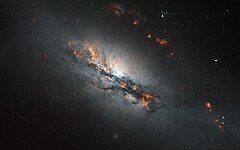NGC 2146
| NGC 2146 | |
|---|---|
 NGC 2146 imaged by the Hubble Space Telescope | |
| Observation data (J2000 epoch) | |
| Constellation | Camelopardalis |
| Right ascension | 06h 18m 37.7112s[1] |
| Declination | +78° 21′ 25.272″[1] |
| Redshift | 0.002999[1] |
| Heliocentric radial velocity | 899 ± 1 km/s[1] |
| Distance | 42.1 ± 3.0 Mly (12.92 ± 0.91 Mpc)[1] |
| Apparent magnitude (V) | 11.38[1] |
| Characteristics | |
| Type | SB(s)ab pec[1] |
| Size | ~124,800 ly (38.25 kpc) (estimated)[1] |
| Apparent size (V) | 6′.0 × 3′.4[1] |
| Other designations | |
| 4C +78.06, IRAS 06106+7822, UGC 3429, MCG +13-05-022, PGC 18797, CGCG 348-017[1] | |
NGC 2146 (also known as the Dusty Hand Galaxy[2]) is a barred spiral galaxy type SB(s)ab pec in the constellation Camelopardalis. The galaxy was discovered in 1876 by Friedrich August Theodor Winnecke.[3]
It has a diameter of 80,000 lyr.[3] The galaxy's most conspicuous feature is the dusty lanes of a spiral arm lying across the core of the galaxy as seen from Earth, the arm having been bent 45 degrees by a close encounter with a smaller galaxy possibly NGC 2146a about 0.8 billion years ago.[3] This close encounter is credited with the relatively high rates of star formation that qualify NGC 2146 as a starburst galaxy.[3]
Supernovae
[edit]NGC 2146 has been host to three known supernova events:
- SN 2005V (type Ib/c, mag. 16),[4] discovered by LIRIS on 30 January 2005.[5][6]
- SN 2018zd (type II, mag. 17.8) is possibly a type IIn[7] and might be the first electron-capture supernova,[8][9][10] and was discovered on 2 March 2018 by Kōichi Itagaki.[11]
- SN 2024abfl (type II, mag. 17.5) was discovered on 15 November 2024 by Kōichi Itagaki.[12]
Gallery
[edit]- SN 2018zd, imaged at Northolt Branch Observatories on 7 March 2018. At that time, the supernova was visible at magnitude +14.0 and brightening.[13]
References
[edit]- ^ a b c d e f g h i j NED (July 16, 2012), Results for search on NGC 2146
- ^ Stoyan, Ronald; Schurig, Stephan (2014). interstellarum Deep Sky Atlas. Erlangen: Cambridge University Press; Oculum-Verlag GmbH. ISBN 978-1-107-50338-0. OCLC 920437579.
- ^ a b c d "Feeling the strain". The Hubble European Space Agency Information Centre. 22 August 2011. Retrieved 6 October 2012.
- ^ "SN 2005V". Transient Name Server. IAU. Retrieved 14 November 2024.
- ^ Mattlla, S; Greimel, R; Meikle, P (2005). "LIRIS Discovers Supernovae in Starburst Galaxies" (PDF). The Newsletter of the Isaac Newton Group of Telescopes. 9: 16. Bibcode:2005INGN....9...16M. Retrieved 8 July 2015.
- ^ "Image of supernova 2005V". rochesterastronomy.org. 4 February 2005. Retrieved 10 March 2018.
- ^ Zhang, Jujia; Xu, Liang; Wang, Xiaofeng (6 March 2018). "ATEL #11379: Spectroscopic Classification of SN 2018zd as a very young Type IIn Supernova". Retrieved 10 March 2018.
- ^ Hiramatsu D, Howell D, Van S, et al. (28 June 2021). "The electron-capture origin of supernova 2018zd". Nat Astron. 5 (9): 903–910. arXiv:2011.02176. Bibcode:2021NatAs...5..903H. doi:10.1038/s41550-021-01384-2. S2CID 226246044.
- ^ "New, Third Type Of Supernova Observed". W. M. Keck Observatory. 28 June 2021.
- ^ "Astronomers discover new type of supernova". RTE News. PA. 28 June 2021. Retrieved 1 July 2021.
In 1980, Ken'ichi Nomoto of the University of Tokyo predicted a third type called an electron capture supernova. ... In an electron capture supernova, as the core runs out of fuel, gravity forces electrons in the core into their atomic nuclei, causing the star to collapse in on itself.
- ^ "SN 2018zd". Transient Name Server. 2 March 2018. Retrieved 10 March 2018.
- ^ "SN 2024abfl". Transient Name Server. IAU. Retrieved 15 November 2024.
- ^ "Supernova 2018zd in NGC 2146". rochesterastronomy.org. 2 March 2018. Retrieved 10 March 2018.
External links
[edit] Media related to NGC 2146 at Wikimedia Commons
Media related to NGC 2146 at Wikimedia Commons


 French
French Deutsch
Deutsch![SN 2018zd, imaged at Northolt Branch Observatories on 7 March 2018. At that time, the supernova was visible at magnitude +14.0 and brightening.[13]](http://upload.wikimedia.org/wikipedia/commons/thumb/d/d2/SN_2018zd_wikipedia.png/120px-SN_2018zd_wikipedia.png)